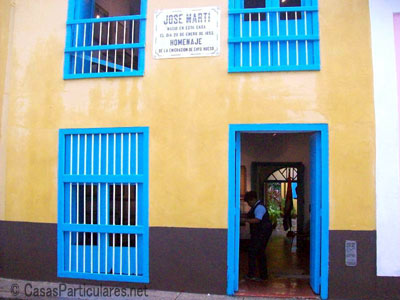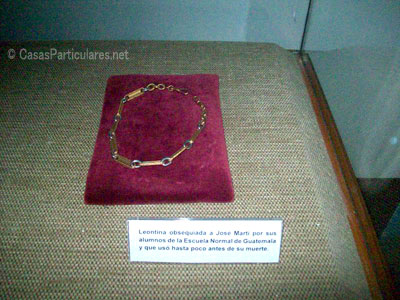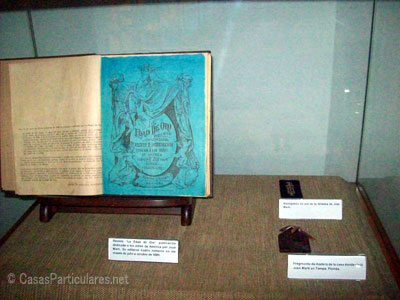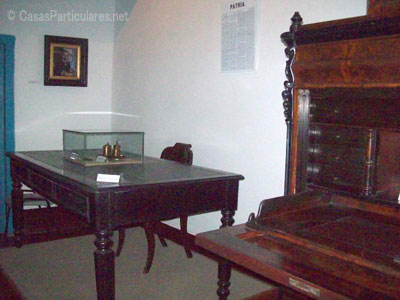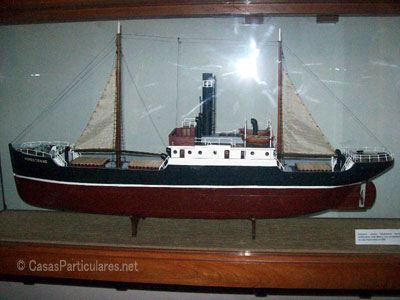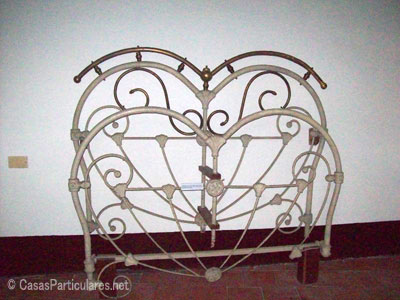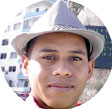The Museum of José Martí Birthpalce
By Luís Suárez, student in journalism (at the time of writing this text), translated from Spanish by Danil Ren.
The José Martí Birthplace Museum
The José Martí birthplace museum was founded in 1925, 75 years after the birth of José Martí, occurred on January 28, 1853, in a room of this same place, to celebrate the birthplace of the National Hero of Cuba.
The museum is located in #314, Leonor Pérez street, between Egido and Picota, Old Havana and, since 1994, it is a national monument under the responsibility of the Historian's Office of Havana.
The José Martí's parents, Don Mariano Martí and Leonor Pérez, lived there until three years after his birth. Then, the house had several owners up to which it was purchased, in 1900, by the For Martí Ladies and Gentlement Association and delivered again to Leonor Pérez, who lived there five more years.
The tag appearing in the façade, between the two doors of the room in the second floor, where Leonor Pérez gave birth to José Martí, was put in 1889 by Cubans migrants living in Cayo Hueso, United States, precisely with the aim to enlight this event.
The house was converted into a museum, thanks to the Arturo de Carricarte de Armas, a journalist who directed a group who compiled and preserved the Apostol's documents, objects and belonging (José Martí is called The Apostol by Cubans).
The museum was declared National Monument in 1949 and, during the celebrations of José Martí's birth centenary, it received in donation the lock of the chain that José Martí brough when young, on October 21, 1869 in the Real C�rcel de La Habana (Real Prison of Havana).
It was on January 28 1963 that the place officially took the name of José Martí's Birthplace Museum. During several years, the National Council of Culture faced the restauration and renovation projects and it was charged to enrich its collections with the rescue of documents and other objects of interest which remained under the custody of the National Archive of Cuba, the Fine Arts National Museum and other organizations, including the City Storiograph Office which direct what it's happening from the constructive point of view.
Eight Halls to Know the José Martí's History
The first hall of the museum is, whithout a doubt, the room where José Julián Martí Pérez was born. However, to be able to reach this room, the visitor, after having entered from the main door, have to cross a portion of the 7th Hall and then find a narrow stair which conducts to the first floor. Once on top, the hall appearing is the number 2 and after that, we finally reach the first hall.
There in the hall, a commemorative tag tells: "En este lugar nació José Martí y Pérez. El viernes 28 de enero de 1853" (In this place, José Martí y Pérez was born. On Friday, January 28, 1853). This room is devoted to remember the birth and the childhood steps, the adolescence and the youth of the Cuban hero. Here, we can find a hair fuse when he was four years old, a little spoon Martí used with his seven sisters, a little beret and a little napkin which were part of his layette, among other belongings.
The lock of the chain that Martí brought in the Real Prison of Havana is also part of that collection. From his mother, Leonor Pérez, we can find some objects, among them, a fan.
In the second room, there are objects which witness the Martí's passage and the circumstances that forced hid to make his travels. For instance, he was deported in Spain in 1871, where he remained until 1874. Then, he lived in Mexico between 1876 and 1877, and at the same time, for a short period, he also stayed in Guatemala.
In this room, there is the facsimile of the dossier he received in the Spanish Zaragoza University between 1873 and 1874, the little chain that he received in gift from his students in the Normal School of Guatemala and a copy of memory album of his wedding with the young Cuban Carmen Zayas-Bazán, from Camagüey province, celebrated in Mexico in 1877.
The Room 3 is located in the basement, it illustrates the presence of Martí in Havana in 1878 and 1879, after he came back in Cuba. This room emphasizes his relationships with the cultural institutions and his activities against the Spanish government in Cuba.
Also you can find a replica of the tailcoat that Martí wore in his performing in Guanabacoa Lyceum. Guanabacoa is a municipality in Havana where the original is found. Back in the room, you can also find the desk he used in 1879, where he was attorney in a studio in Old Havana.
Also notable is that, in this room, it was born, on November 22, 1878, Jos� Francisco Martí Zayas-Baz�n, the only son José Martí had. Aside from that and at the end, there is Room 4, where a glass urn is devoted to objects belonged to José Francisco Martí.
Among the first group ob objects which are part of the 4th room, there are details about the Martí's arrival in the United States in 1880 and about his stay in Venezuela in 1881. Furthermore you can find evidences of José Martí's works as a consul in New York, in Uruguay (1884-1891), Argentina and Paraguay (1890-1891), after his return to the United States; and the room communicate to us how he renounced to all of his responsabilities with the aim to prepare from outside the War of Independence of Cuba, also known as the war or 1895.
Parts of this collection are a gold monogram and a wallet, also an exemplary of the magazine "La Edad De Oro", a publishing created for the children of Latin America. Important and ancient documents, put in the walls behind the glasses and spread everywhere in the museum contribute to a better understanding of each step of Martí's life.
The 5th Room recreated the office where José Martí performed a distinctive work as a consul in New York, located in the room 13 of the 120th building, Front Sreet. A portrait, made in 1891, by the Swedish artist Herman Norman, the desk and the meeting table coming from the same place that, also was the headquarter of the Cuban Revolutionary Party, founded on April 10, 1892, help to improve the ambience of the place.
Attempting to reproduce such place was necessary if we take into account that aside from being the seat of El Partido, the Major Martí's work, was also used to write Patria, a newspaper of revolutionary aspirations which was issued for the first time on March 14, 1892. In honor of this the Day of Cuban Press is celebrated.
The Room 6 contains objects and documents which witness several actions José Martí took from different countries as a delegate of the Cuban Revolutionary Party, so to begin again the fight for the Independence of Cuba; these ones began on October 10, 1868 and had failed because of lack of unity. The room also illustrates the circumstances under which, on February 24, 1895, the war in the Cuban Orient restarted again.
There is also a cap that Martí received in gift on January 28, 1894 from his friend, the Equatorian Eloy Alfaro, who became later the president of the Equator Republic in the times (1897-1901) and (1906-1911); the inkpot and the pen belonged to the Dominican Máximo Gómez, which was used by the Cuban hero on March 25 1895, in the writing of the Montecristi Manifesto, document where the basical ideas of the war organization in 1895 are exposed.
Is also possible to know that, after having signed the Manifesto in Dominican Republic, José Martí made a travel together with Máximo Gómez and other patriots to Cuba to make part to the was that begun on February 24. Before that they pass throughout Cabo Haitiano, Haiti.
The Room 7 has a replica of the German cargo ship that bring them to Cuba, on April 11 1895, in Playitas de Cajobabo, Guantanamo. This room also exposes the José Martí's fall in combat, on May 19, 1895, in Dos R�os, a territory belonging to the Granma province.
The museum has the honor to preserve the objects Martí had with him when he fell in combat: a pencil sharpener, the spurs and a ribbon which belonged to Carlos Manuel de C�spedes, also known as the Patria Father and beginner of the two independence wars of Cuba, on Octuber 10 1868.
In the collection is also present the José Martí National Order (the higest decoration the State Council of Cuba grant to people for exceptional achievements), which Arnaldo Tamayo Méndez, Cuban spaceman, brang to space. Arnaldo Tamayo was the first Cuban who traveled the space on September 18 1980; he donated the order to the museum during a visit he made on may 19, 1980.
Finally, the Room 8, many times unnoticed because of the fact it is located above the Room 3, has a close relationship with the Room 6 and keep, for instance, parts of a bed where José Martí slept during his stay in Cayo Hueso.
Meeting the Most Universal of Cubans
Because of the sign he leaved in several countries and because of his large work of international reach, José Martí is also considered as the most universal of Cubans. To experiment the validity of this qualifier, you just have to arrive at the Birthplace Museum where all the history will be introduced in a pleasant way, through the path along the eight exposition rooms, open to the public from Tuesday to Saturday (from 9AM to 5PM) and the Sunday (from 9:30 to 12).
The children less than 12 can access the museum for free, while all others have to subscribe two quotes of the currency which correspond to them. For more informations about the National Hero of Cuba, in face of the museum there is the Ferm�n Vald�s Dom�nguez library, open from Monday to Saturday, from 9:30 am to 4:30 PM, with more than 500 books for anyone interested.
The José Martí Birthplace Museum, which distinguish itself because of its colors, yellow in the walls and blue in windows and doors, is also considered as a cultural complex for the several activities it promotes, mainly directed to children of the community from the near Mariano Martí primary schook.
Assumed that José Martí was an exceptional man, visiting this museum is mandatory, so not only you can say you are part of 60 thousand visitors who arrive each year, but you're also knowing an essential part of the history of Cuba.







